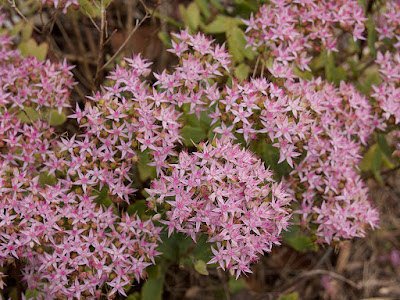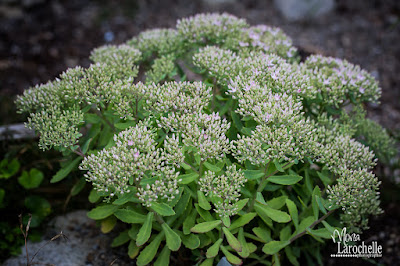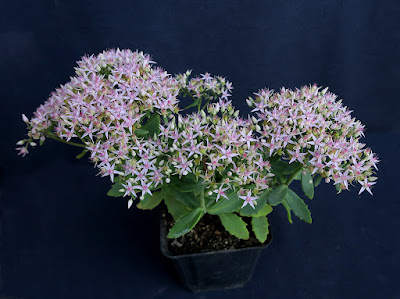Sedum Pure Joy - Pure Joy Sedum is characterized by large grey green foliage wwith pink bi-color flowers and compact mounded plant habit.
Sedum Pure Joy, also called as Pure Joy Sedum, Pure Joy Stonecrop, is a cultivar in the Sedum genus. This cultivar was discovered by Brent Horvath in Hebron, Ill. in 2005.
DESCRIPTION OF SEDUM PURE JOY - PURE JOY SEDUM
Sedum Pure Joy is a seedling from open pollinated seed sown from an unnamed Sedum tatranowii. Initial asexual reproduction by means of division, and vegetative cuttings has shown this plant are stable and identical in reproduction to the originally discovered plant.
It is an evergreen perennial herb which reaching 25-30 cm tall by 50 cm spread with compact and mounded plant habit. The stems are green colored, 25-30 cm long, rounded, glabrous. The leaves are deciduous, obovate, 5-6 cm long by 2 cm wide, dentate margin, obtuse apex, cuneate base, smooth, alternate, grey green in color.
Pure Joy Sedum blooms in summer to autumn from the paniculate inflorescences with about 1500 flowers per panicle. The flowers are star-shaped, pink colored with creamy white buds and are held on the purple colored peduncle.
SEDUM PURE JOY - PURE JOY SEDUM CARE AND CULTURE
Cultural information should only be used as a guide, and should be to be adapted to suit you. Your physical location; where you grow your plants, how much time you have to devote to their care, and many other factors, will need to be taken into account. Only then can you decide on the cultural methods that best suit you and your plants.
Light and exposure:
Sedum Pure Joy will tolerate partial shade (not full shade), but do best in full sun (6 or more hours of direct sun per day). The higher the better in most cases, a minimum of 50000 lux. The plant require high light to develop strong leaf coloration and will stretch badly under low light conditions. Low light levels can be offset with dry soil conditions, but only for a short period of time.
Temperature:
Pure Joy Sedum can grow in USDA zone 4-9. The plant prefers the night temperatures of above 13 °C and day time temperature must be at least 18-21 °C. However, the hot days of summer will not be a problem and the temperature of 38 °C can still produce good quality plants. High temperatures and high humidity can create a lot of disease issues, so stay on the lookout.
The plant can tolerate freezing temperature. When the temperature drop below 10 °C the plant start to go dormant. If you experiment with the plant that are borderline resistant to freezing temperatures, or if you live in an area where the temperature frequently drops below freezing, then consider growing the plant in containers so you can move them indoors for protection from cold conditions.
Substrate and growing media:
Sedum Pure Joy can grow in pot, container or in garden with loose loamy, sandy, or gravelly soil with sharp drainage. Unglazed clay or terra cotta containers dry out more quickly than glazed pottery or plastic pots. When the soil retains too much water, as is often the case with a heavy wet clay soil, this can easily lead to root rot for the plant.
The plant in containers do require little more care than those in gardens. Repot your plants when they outgrow their current pot by moving them out to a larger container to hold the plant better. Spring is the best time to repot.
Watering:
Pure Joy Sedum are drought-tolerant but do need some water. They do their best with regular watering from spring through fall. Water thoroughly and wait for the soil to dry out before watering again. Young plant will need supplemental water for the first couple of weeks to establish roots. Established plants, as long as your area gets rain every couple of weeks at the least, shouldn’t need any extra watering. Avoid wetting the leaves, stems, and flowers when watering. In winter, water just enough to keep your plants from shriveling.
Fertilizer:
Sedum Pure Joy typically needs no supplemental fertilization and can tolerate nutrient-poor soil. In fact, if the soil is too rich, this can cause weak, leggy growth. If you have very poor soil, mixing some compost into it will generally be enough to give your plant a boost. Chemical fertilizer can lead to stretching and flopping.
Winter period:
Care needs to be taken to avoid overwatering and over-fertilizing any of these plants especially during the short days, lower light levels, and cooler conditions of winter.
Covering the plant with a layer of straw or placing a tent made from plastic or bed sheets over the plants can protect them from sudden freezing temperatures; don't allow plastic to touch the plants, however. Remove any kind of covering as soon as the temperature warms.
Pruning:
Pure Joy Sedum don't need deadheading (removing spent blooms), and they often look good even into winter. However, extreme heat and a lack of sunlight both can cause the plants to get a bit leggy. Cutting back the plants after they are done flowering can help to maintain their shape and encourage bushier, sturdier growth.
Pests and diseases:
If over watered or overcrowded, the plant may be subject to infestation by scale insects and/or mealybugs. Slugs and snails may also be problematic outdoors. As with all succulents, overwatering, overcrowding and lack of good air circulation can lead to root and stem rot. To avoid these problems, be sure to give your plants plenty of space to grow and spread. Use an appropriate pesticide to deal with mealybugs and scale insects indoors. Outdoors, encourage natural predators, such as ladybugs and lacewings. Pickoff slugs and snails by hand. Thin plants to reduce hiding places and improve air circulation. Reduce watering to make the environment less welcoming to slugs and snails. Crushed eggshells and/or diatomaceous earth sprinkled on the ground around affected plants may discourage these gastropods.
Propagation:
Sedum Pure Joy is very easy to propagate either by stem cuttings or division. For a stem cutting, take cuttings in spring when the plants are in the period of active growth, simply trim off a portion of stem from a healthy plant that's roughly 3 to 6 inches long, and remove the leaves on the lower half. Then, plant the cut end in soil wherever you wish. These prolific stems often will send out roots even if they're just lying on top of soil, but planting them will give them a better shot at healthy growth.
Each leaves could potentially become a new plant. Choose healthy leaves, remove them from the plant, and allow them to callus for several days. Place the leaves on a well-draining soil mix and keep the soil slightly moist. They should be well rooted after about 2 to 3 weeks, with new plantlets forming at the base.
To propagate by division, gently dig up a mature plant, and carefully pull apart the roots to separate it into sections. Then, simply replant the sections, making sure the top of the root ball is level with the soil line. Like the stem cuttings, divided sections also will typically be quick to take root.

















COMMENTS